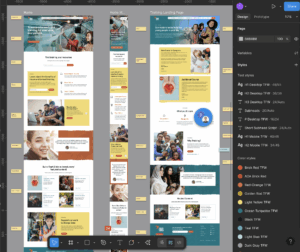
Bridging the gap between design and development (so you don’t have to)

If you’ve ever been part of a digital project, you know how frustrating it can be when the design and development teams don’t seem to be on the same page.
The result? Beautiful designs that break down in development. Functionality that ignores user needs. Missed deadlines. Unnecessary rounds of revisions.
At Creed, we take a different approach: by having both under the same roof, we close the gap between design and development so you don’t have to. From the very first sketch to the final quality checks, our designers and developers work side-by-side to deliver solutions that are both beautiful and usable — with no surprises along the way.
Here’s how that benefits you as our client.
Starting with a shared understanding
We include both designers and developers from day one of your project — during the Discovery phase — to make sure everyone is aligned on your goals, technical realities, and your users’ needs.
We lead you through a collaborative intake process and stakeholder interviews to uncover what really matters. This way, we can anticipate challenges, avoid wasted effort, and set realistic expectations right from the start. Think of it as the blueprint that makes creating the house much easier and cost effective.
Designing with the build in mind
Our designers don’t just make things look good; they design experiences that actually work: technically, financially, and for your users’ experiences.
We do this by:
- Aligning early with developers on what’s feasible for your platform or framework.
- Designing reusable, scalable components so your product is easier to maintain and grow down the road.
- Setting up designs that reflect how your product will actually behave on real devices and screen sizes, not just in a static mockup.
The result: designs that translate smoothly into a functional product.
Wireframes and prototypes help everyone see the same thing

We know it can be hard to envision how a product will really work when all you see are static screens. That’s why we prototype early and often.
These interactive previews help everyone — you, designers, and developers — spot issues with interactions, edge cases, and animations before they become expensive to fix or interfere with your user experience.
We also invite our developers to weigh in on prototypes before the final design is locked, so you’re not stuck between competing priorities later.
Staying connected through the build
When it’s time to build, we don’t just “hand off” the design and walk away.
Our designers stay involved throughout development to ensure that what gets built matches what was promised and to make smart tradeoffs if surprises come up.
We use collaborative tools like Figma and Jira to keep everyone aligned and maintain open communication, so you’re not stuck playing middleman between teams.
Design QA: Catching what tools can’t
Before launch, we conduct a Design QA — a joint review of the nearly-complete product.
This step ensures we catch inconsistencies, gaps, or friction points that automated tools can’t detect, things that impact user confidence and trust.
We don’t chase pixel-perfection for its own sake. Instead, we prioritize fixes that actually matter to your users and your business goals, within your timeline.
Why this matters
When you work with Creed, you’re not juggling disconnected teams or trying to translate between designers and developers. You get a unified crew that listens closely, asks smart questions, and works together to bring your vision to life, from first draft to final details.
This collaboration made all the difference for Trauma Free World, a global nonprofit that came to us for a full website redesign to support their growing programs and digital products.
“Creed’s attention to detail and commitment to getting it right exceeded my expectations,” says Diane Hersberger, Vice President of Operations at Trauma Free World. “They really listened, asked thoughtful questions, and worked closely with us to refine every element until it matched our vision.”
At Creed, we don’t treat collaboration as an optional phase, it’s baked into how we work. That alignment helps you launch faster, with fewer surprises, and a better experience for your users.
